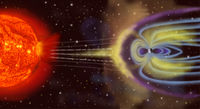
Photo from wikipedia
In early September 2017, several space weather events triggered disturbed conditions of the near-Earth space. The combination of two coronal mass ejection arrivals, associated with an X-class flare, caused a… Click to show full abstract
In early September 2017, several space weather events triggered disturbed conditions of the near-Earth space. The combination of two coronal mass ejection arrivals, associated with an X-class flare, caused a strong geomagnetic storm on 7 and 8 September, thus inducing diffuse ionospheric phase scintillations on Global Navigation Satellite System (GNSS) signals. This work analyzes the effects and the actual impact of such phase scintillations on transionospheric Global Positioning System (GPS) signals and on related positioning accuracy. The research focuses in particular on high-latitude GPS L1 data, recorded during a test campaign in Svalbard, Norway. The joint effect of satellites at low elevation and the exposure of ionosphere to the geospace forcing make navigation a critical task for such a challenging environment. Data analysis shows that the performance of carrier smoothing algorithms was affected by the presence of moderate and strong phase scintillation. It is shown in this study that positioning errors double when GPS signals affected by scintillation are used. This work shows that scintillations induce a considerable clustering effect on the smoothed positioning solutions; therefore, a methodology to automatically and autonomously detect the boundaries of the scintillation event is suggested according to such an high-level effect. The use of software-defined radio receivers for automatically capturing and processing GNSS data affected by scintillation is an added value to the analysis, as it offers the possibility to implement advanced signal processing techniques and a deeper observation of the impact of scintillations on the signals. Plain Language Summary Global Navigation Satellite Systems, such as GPS, are widely used for positioning, navigation, and scientific purposes. However, such signals are subject to severe nuisances as they cross the upper part of the Earth atmosphere, the ionosphere. In particular, space weather events, as the one occurred in early September 2017, can further disrupt the quality of the received signals and, in turn, the accuracy, availability, continuity, and reliability of the positioning solution. In this work we show how the September 2017 storm affected GPS signals, focusing on data captured at Svalbard Islands, a region highly disturbed by space weather events, due to its proximity to the geomagnetic pole. More in detail, we focus on the actual impact of ionospheric phase scintillation induced by the storm. Data analysis shows that the performance of certain algorithms, employing phase measurements to increase the positioning accuracy, such as carrier smoothing, is affected by the presence of moderate and strong phase scintillation. The positioning error doubles, when compared to the case in which no scintillation is present. The work also shows that scintillation induces a considerable clustering effect on the positioning solutions, thus suggesting a novel methodology for automatically and autonomously detecting space weather events.
Journal Title: Social Work
Year Published: 2018
Link to full text (if available)
Share on Social Media: Sign Up to like & get
recommendations!